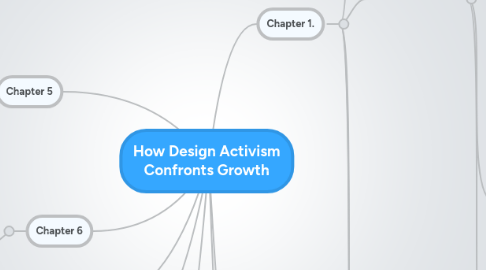
1. Chapter 4
1.1. Sustainable economy
1.1.1. normalize the inclusion of social values through market mechanisms
1.1.1.1. Other institution than the market
1.1.2. How design activist soak up income without increasing economic growth
2. Chapter 5
2.1. Classic activist methods
2.2. Design example
3. Chapter 6
3.1. Power dynamics underlying activist methods
3.1.1. Capacities (have to build power)
3.1.1.1. disruption
3.1.1.2. framing
3.1.1.3. targeting
4. Chapter 7
4.1. Post-growth scenario
5. Chapter 8
5.1. Conclusion
6. Chapter 1.
6.1. Clarify term
6.1.1. Activism
6.1.1.1. wronged, excluded, or neglected group
6.1.1.2. take action
6.1.1.3. call for change
6.1.1.4. low budget
6.1.1.5. collective action, loose coordination
6.1.2. Good design
6.1.2.1. usable, profitable, beautiful, meaningful
6.1.3. What should we change
6.1.3.1. sustainable development
6.1.3.1.1. issues
6.1.3.1.2. suggestion
6.1.3.2. consumerism driven economic growth initiatives stole money from agenda setters/designers
6.2. Situate the book
6.2.1. Design
6.2.1.1. Scope: physical/spatial design
6.2.1.2. Views
6.2.1.2.1. Within design
6.2.1.2.2. From outside design
6.2.2. Social change
6.2.2.1. perspectives
6.2.2.1.1. business and commerce
6.2.2.1.2. information and communication
6.2.2.1.3. cultural identity
6.2.2.1.4. frame design in social movement activism terms
6.2.2.2. Relevance of movements to contemporary society
6.2.2.2.1. collaboration
6.2.2.2.2. evolving
6.2.2.2.3. challenge
6.2.3. Economics/Sustainable Consumption
6.2.3.1. over-consumption countries
6.2.3.1.1. US
6.2.3.1.2. UK
6.2.3.2. problems of continuous economic growth
6.2.3.2.1. efficiency haven't outrun consumption
6.2.3.2.2. individual consumer level: efficiency gain generates more consumption
6.2.3.2.3. T. Jackson "Prosperity without growth"
6.3. Widening the range of beneficiaries of activism
6.3.1. focusing groups
6.3.1.1. socially excluded
6.3.1.2. middle-class people
6.3.1.3. entire population
6.3.2. means
6.3.2.1. cut back consumption of the wealthiest 20%
6.3.2.2. demonstrate better consuming model
6.3.2.3. increase consumption of the poorest 20%
6.3.2.4. reduce population size. T. Jackson
6.4. Tension: design and politics
6.4.1. politics absent from architecture
6.4.2. tension sources:
6.4.2.1. concerns: balancing political commitment with professional responsibility
6.4.2.2. layered content in action
6.4.2.3. infrastructure
6.5. Examples and sources
6.5.1. practitioner experiences
6.5.2. scholarly thinking
7. Chapter 2.
7.1. Outline the systemic issues of consumerism and growth
7.1.1. How these are shaped by design
7.1.2. Four specific challenges
8. Chapter 3
8.1. Project-level design activism
8.2. How results of activist work are measured
8.2.1. activists are engaged in political struggles converge on the four challenges

